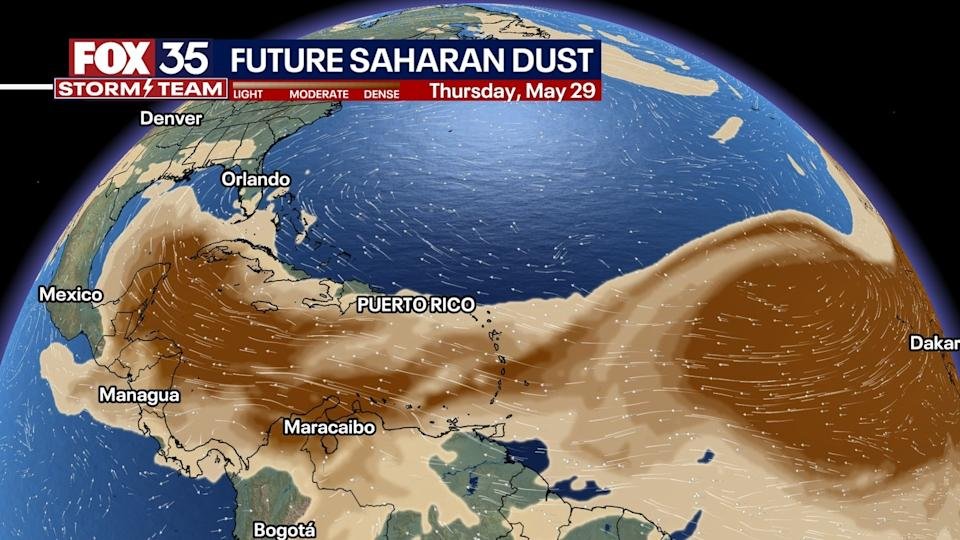Florida
Massive Saharan Dust Plume Headed for Florida Sparks Health Warnings and Visibility Alerts
As dry air and haze sweep in from Africa’s desert skies Floridians are urged to take precautions especially those with respiratory issues

A vast plume of Saharan dust is making its way across the Atlantic and is expected to arrive in Florida’s skies this week, bringing with it a wave of hazy sunsets—and potential health concerns.
This natural phenomenon, known as the Saharan Air Layer (SAL), occurs when strong winds lift dry, dusty air from the Sahara Desert and carry it across the ocean. While this is a common summer occurrence, the latest plume is unusually large, and experts warn that it could temporarily impact air quality across much of the Sunshine State.
According to the National Weather Service, residents in South and Central Florida may begin noticing a milky haze and reduced visibility. While the dust can enhance sunrise and sunset colors, it can also cause breathing issues, particularly for people with asthma, allergies, or chronic respiratory conditions.
“The Saharan dust contains fine particulate matter that can irritate the lungs,” said a spokesperson from the Florida Department of Health. “People with underlying health issues, seniors, and young children should minimize prolonged outdoor exposure while the plume is overhead.”
Is the Saharan dust dangerous?
For most healthy individuals, the dust is not considered dangerous, but it may cause symptoms such as coughing, throat irritation, watery eyes, and mild shortness of breath. Those with preexisting lung conditions should be especially cautious.
Local officials are also monitoring air quality levels closely. In areas where the dust concentration peaks, Air Quality Index (AQI) levels could temporarily dip into the “unhealthy for sensitive groups” category.
How to protect yourself:
- Limit time outdoors, especially during peak afternoon hours.
- Use N95 masks or other high-filtration masks if you must be outside for extended periods.
- Run air purifiers indoors and keep windows closed to reduce indoor exposure.
- Stay hydrated and monitor symptoms if you have a respiratory condition.
- Follow updates from local weather and health departments.
The silver lining to the dusty skies? The Saharan Air Layer often suppresses hurricane activity, as the dry air and wind shear make it harder for tropical systems to develop. So while it may be a nuisance for sensitive groups, it could offer a temporary break from early-season storm threats.
As the plume continues to drift westward, Floridians are encouraged to stay informed and make temporary lifestyle adjustments to reduce exposure. The dust event is expected to linger through the weekend before conditions gradually improve.

Florida
Massive Airport Makeover Set to Transform Orlando Travel Experience
Orlando International and Sanford Airports gear up for major upgrades to boost passenger comfort, tech, and capacity

Big changes are coming to the skies — and they start on the ground in Orlando. Both Orlando International Airport (MCO) and Orlando Sanford International Airport (SFB) are preparing for significant upgrades, promising to redefine how millions of travelers experience Central Florida.
Whether you’re arriving for a magical Disney vacation or heading out on business, the airport is your first impression — and Orlando’s top travel hubs are making sure it’s a great one.
In a recent briefing, Kevin Thibault, CEO of the Greater Orlando Aviation Authority, revealed ambitious plans to expand and enhance MCO’s infrastructure. The centerpiece? A major expansion of Terminal C, just two years after it first opened. The new plan includes more gates, futuristic baggage handling, biometric check-ins, and eco-conscious upgrades designed to handle growing passenger demand — which soared past 50 million last year.
“Travelers expect more than just a seat on a plane — they want speed, comfort, and a little bit of magic,” Thibault said. “And we’re delivering that.”
Meanwhile, over at Sanford International Airport, officials are getting ready to roll out their own set of improvements. Known for its ease of access and low-cost carriers, Sanford will soon boast expanded concourses, more modern amenities, and smarter parking and transport systems. The aim? To keep things simple, fast, and traveler-friendly.
But there’s more to this than just convenience. These upgrades are deeply tied to Florida’s booming tourism and business ecosystem. With travel demand on a sharp upward climb, airport officials are acting fast to make sure both airports are future-ready — not just for the next five years, but for decades to come.
What makes this renovation cycle truly exciting is the tech-first, traveler-first approach. Orlando International is integrating smarter signage, faster security, energy-efficient materials, and even intermodal transit options that could soon link air travel with trains and buses in a seamless loop. The result? Less stress, more efficiency, and a smoother journey from gate to getaway.
Local leaders are applauding the move, seeing these updates as more than infrastructure — they’re a vote of confidence in Central Florida’s position as a global travel hub. The upgrades are expected to generate hundreds of jobs, draw in more airlines, and give returning visitors and first-timers alike a world-class welcome.
So, whether you’re a frequent flyer or planning your next Florida escape, get ready to land in something extraordinary. Orlando’s airports are evolving — and they’re doing it with you in mind.
-

 US News1 week ago
US News1 week ago“She Never Made It Out…” Albany House Fire Claims Woman’s Life as Family Pleads for Help to Bring Her Home
-

 Entertainment6 days ago
Entertainment6 days agoXG Star Cocona Shares a Brave Truth at 20 — “I Was Born Female, But That Label Never Represented Who I Truly Am…”
-

 Entertainment6 days ago
Entertainment6 days agoSamba Schutte Reveals the Surprise Cameo in Pluribus That “Nobody Saw Coming”… and Why John Cena Was Perfect for the Role
-

 Entertainment1 week ago
Entertainment1 week agoNika & Madison stuns global audiences as director Eva Thomas reveals why “resilience, not fear, drives Indigenous women on the run”
-

 Tech1 week ago
Tech1 week agoAfter Losing Over $70 Billion, Mark Zuckerberg Finally Admits His Biggest Bet Is “Not Working” – Meta Plans Massive Cuts to Metaverse Budget
-

 Entertainment5 days ago
Entertainment5 days ago“America Under a Dictatorship?” New ‘The Boys’ Trailer Teases a Terrifying Final Season… and Billy Butcher’s Last Stand
-

 Entertainment1 week ago
Entertainment1 week agoGuillermo del Toro earns Britain’s highest film honor: BFI Fellowship announced… the director says “This is the honor of a lifetime”
-

 Entertainment1 week ago
Entertainment1 week agoNew York Film Critics Circle 2025 winners shock Hollywood: ‘One Battle After Another’ crowned Best Film… but the real surprises came elsewhere















